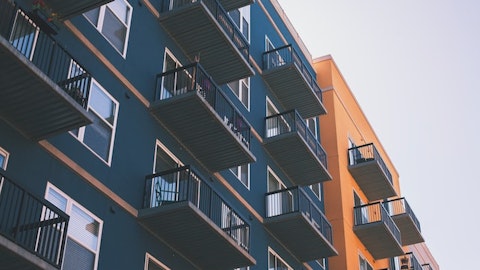John Kite: Sure. I mean, Connor, we’re always focused on how we can increase margins, which is probably why we have the highest NOI margin in the business and one of the highest recovery ratios consistently over time. I think frankly, controlling cost and getting better growth, that’s what it’s all about. And that’s how we create free cash flow. We’re already very good at it. We’re already the market leader in fixed CAM and the open-air space. So, we’re just leaning into that more. We don’t — we’re not going to get into specifics about what those exact margins are, fixed CAM versus triple net, et cetera. Suffice to say, we’re the leader. So that ought to tell you something, we’re or generally close to the top. So — but the other things that we’re doing right now to take advantage of the environment is all the things within the lease.
All the things that we look at within the lease. For example, when you look at our overage rent, our percentage rent that comes from sales, it’s higher than it’s ever been. It continues to be kind of an extra cherry on the top, but it should be because our tenants are doing great when they’re paying that percentage rent. That obviously increases margins. And then just how we look at the leases themselves in terms of exclusives, in terms of co-tenancy requirements, it’s a situation where we want to take care of our customer, but we also have to take care of the business. And over time, it’s gotten — continues to improve. And I don’t think people talk enough about when you do business with a company like ours or some others, the retailer themselves would prefer to do business with somebody like us who delivers.
It’s one thing that you have a space that somebody wants, but it’s another thing, how do we reinvest in our properties? How are we — going about that, you’re making it very, very attractive to the consumer. So, I think retailers appreciate that and they’re willing to pay for that in the right circumstances.
Tom McGowan: Yes. I mean the only other one I would add is one of the key goals for our company is, of course, start rent as quickly as possible. And we have this machine at Kite that’s got predevelopment tenant coordination project managers. And it’s our job to work with all these tenants where they may struggle with permits, et cetera, and run into problems on code issues and really work to get these tenants open as quickly as possible. We don’t look at it as just a tenant issue. We look at it as our issue as well. So, another big point of trying to generate that revenue earlier.
Connor Mitchell: Okay. I appreciate all the color there. And then bad debt was — the guidance was brought down. And just kind of thinking about some factors from the past, Bed Bath and Joan seem to be relatively seamless for the industry. Is there any chance like we could be getting involved into a sense of false fewer credit issues? Or maybe the sector’s ability to wrangle troubled tenants?
John Kite: I don’t know about that. I mean we’re — as we laid out in our prepared remarks, I mean, when you look at the first quarter for us, if you excluded prior periods, we were around 90 basis points. So, the bottom line is you can say when you exclude prior periods, but we’re — that’s part of our business. We’re always collecting. We just don’t want to project that because it’s volatile. So, if you’re assuming that bad debt is around 1%, and you’re always going to be collecting something, that’s probably pretty stable. So, I don’t think we’re being [indiscernible]. It’s a function of the fact that supply and demand is putting us in a position that tenants want to be in these spaces, and they’re going to do everything in their power to continue to stay there, which means pay rent.
So, I don’t think that it’s particularly different, but it’s better. Look, the reality is it’s better. But right now, we’re being conservative in looking at the balance of the year, and we’ll see where it shakes out.
Operator: And our next question comes from the line of Lizzy Doykan from Bank of America.
Lizzy Doykan: I was hoping to get more color on the leasing spread on option renewals in the quarter, which looks like that compressed for the third straight quarter. And when I’m looking at the past four quarters, it looks like option renewals made up over 60% of the comparable space that’s been executed. So just wanted to see what’s going on there? What’s sort of been happening in the renewal discussions you’re having with tenants? And maybe why is this proportion not coming down? Maybe are you signing renewals with fewer options?
John Kite: No. So well, first of all, we’re not having a lot of discussions on an option renewal because the tenant is just hitting an option. So, let’s start there. And if you have a particular quarter where you have multiple anchor options, anchors hitting options, generally speaking, those aren’t — those are lower. So, I think a lot of it’s timing. And over the last couple of quarters, I think we probably had more anchors. I’m not looking at the data in front of me. But it really comes down to mix. What is the mix per quarter. It’s kind of why we talk about non-option renewals. And when I look over the past, I think, 2.5 years, the non-option renewals have been 12%. So, our goal is to have less options. I mean it’s part of our strategy around new leasing and containing the options. And if the options do exist that we have to get the appropriate rental increases in those options, but it would be pretty focused on the anchor side, and that’s it.
Lizzy Doykan: Okay, thanks. And then back to Heath’s comments on the 500 basis points to 600 basis points of occupancy build that’s expected over the next two years to three years. Just curious on how much you think that would be weighted towards anchors versus small shops? And then maybe is there thoughts around the cadence over which that would happen, whether that’s the most weighted in the back half of ’24 versus 2025, 2026?


